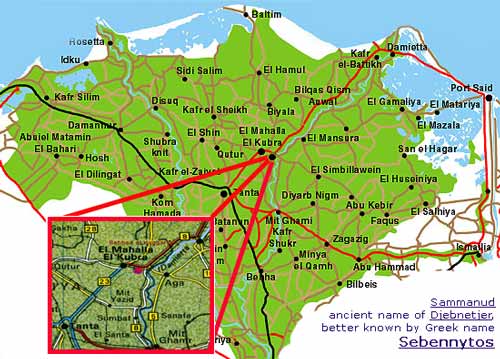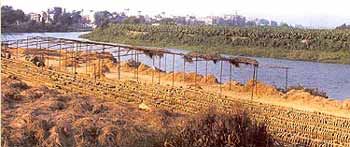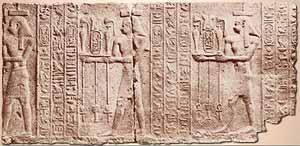 Samannud
SamannudCentral Delta town is located on the Damietta branch of the Nile about 6 km to the east of el-Mahalla el-Khubra. The town better known by its Greek name, Sebennytos, as being the home of the Egyptian historian Manetho. In his history Manetho described Sebennytos as being the town from which Nectanebo I Kheperkara (30th Dynasty) launched his offensive against the Persian invaders of the Delta.
 Located on the Damietta branch of the Nile in the Egyptian Delta, the modern
town of Samannud, a cotton marketing centre, is 6km east of el-Mahalla el-Kubra,
and is the site of ancient Tjebnutjer (coptic Djebenoute or Djemnouti), which
the Greeks called Sebennytos. It was the capital of Egypt's 12th Lower nome.
Manetho, perhaps the greatest of the native Egyptian historians, was from this
region, and claims that it was the home of the 30th Dynasty kings.
Located on the Damietta branch of the Nile in the Egyptian Delta, the modern
town of Samannud, a cotton marketing centre, is 6km east of el-Mahalla el-Kubra,
and is the site of ancient Tjebnutjer (coptic Djebenoute or Djemnouti), which
the Greeks called Sebennytos. It was the capital of Egypt's 12th Lower nome.
Manetho, perhaps the greatest of the native Egyptian historians, was from this
region, and claims that it was the home of the 30th Dynasty kings.
There are remains, though mostly only a mound, of a temple dedicated to the local god, Onuris-Shu (Anhur-Shu) who was a hunter and sky-god. It was probably at this temple that Manetho served as a priest. It is located on the western side of the modern town. There are scattered granite blocks from the site inscribed with the names of Nectanebo II, Alexander IV, Philip Arrhidaeus and Ptolemy II, with none of the inscriptions appearing to predate the 30th Dynasty. Some items found here are said to have come from neighbouring towns, including an Old Kingdom false door, an altar of Amenemhat I, a statue dated to Psammetichus I, a fragment of a shrine of Nephrites and a sculpture dating to the reign of Nectanebo I.
 The
ancient Egyptian town was capital of the 12th Lower
Egyptian Nome during the Late Period. There are few remains of Sebennytos today,
although a mound still marks the site of the town and covers the remains of a
temple begun by Nectanebo I - an important shrine dedicated to the sky-god
Onuris-Shu who was identified with the Greek war-god Ares during the Ptolemaic
Period. The cult of Onuris was first attested in the Thinite Nome near Abydos,
from the Old Kingdom and Onuris-Shu and his consort Mehyt had cult centres at
both Samannud and This.
The
ancient Egyptian town was capital of the 12th Lower
Egyptian Nome during the Late Period. There are few remains of Sebennytos today,
although a mound still marks the site of the town and covers the remains of a
temple begun by Nectanebo I - an important shrine dedicated to the sky-god
Onuris-Shu who was identified with the Greek war-god Ares during the Ptolemaic
Period. The cult of Onuris was first attested in the Thinite Nome near Abydos,
from the Old Kingdom and Onuris-Shu and his consort Mehyt had cult centres at
both Samannud and This.
The temple at Sebennytos was decorated by Nectanebo II Senedjemibre, the last
true Egyptian ruler until modern times, with later inscriptions of Philip
Arrhidaeus, Alexander IV and Ptolemy II Philadelphus. Although the temple was
documented as still being in existence during the 15th century AD, it was
dismantled shortly afterwards, leaving only a scattered collection of granite,
limestone and basalt blocks as the only visible remains to mark its presence.
Edward Naville visited the site in 1887 and published a series of line drawings
illustrating some of the reliefs found on blocks there. Many of the decorated
blocks were removed to museums around the world, some remaining inscribed blocks
as well as other architectural fragments have recently been put on display in an
open-air storage magazine at the site by the Supreme Council of Antiquities.
| An epigraphic survey of Samannud was directed by Neal A Spencer for the Egypt
Exploration Society (EES) in 1998 and many fragmentary remains were recorded and
published. Much of the site has been encroached upon by the modern town and
there are insufficient remains to reconstruct the temple of Onuris-Shu, but
remaining blocks suggest that the 30th Dynasty temple had been constructed on a
scale comparable to other contemporary sites. It would appear that some of the
stone was re-used or removed to nearby sites, such as the temple at Behbeit
el-Hagar to the north, which may have had a link with Sebennytos, or to Abu Sir
Bana (Busiris) to the south. Additional blocks have been found in the modern
town of Samannud and nearby villages. It is thought possible that the kings of 30th Dynasty were buried within the temple precinct, but so far no archaeological investigation of burials has been undertaken. |

|
Behbeit el-Hagar
Behbeit el-Hagar, a village just a few kilometres to the north of Samannud (Sebennytos)
in the central Delta, marks the site of an important, though now destroyed
temple, thought to have been known to the Greeks as The Iseum. The temple was
probably linked to the town and temple of Sebennytos, home of the Dynasty XXX
kings towards the end of the Late Period, as well as to the nearby Nome capital
of Busiris.
The modern village derives its name from the ancient 'Per-Hebit’, meaning 'The
domain of the Festive Goddess’ and the temple, 'Hebit’, seems to refer to a
festival pavillion dedicated to the goddess Isis and the funerary rites with
which she was associated. The site covers an area of about 7.6 hectares and is
surrounded by cultivation on all sides. Ruins of a massive mudbrick enclosure
wall constructed around the perimeter of the temple can still be seen on the
northern and southern sides, but inside the enclosure only a tumbled mass of
granite blocks lying on the surface remain to define the position of the temple,
an area measuring around 80m by 55m. The great attraction to visitors of the
site today is in the very finely carved reliefs on the broken granite blocks,
much more delicate in style than the Ptolemaic reliefs in temples of Upper
Egypt.
Little is known of the early history of the site, though textural evidence
suggests that there may have been a structure here from the late Saite Period.
The names of the builders of the early Ptolemaic temple recovered from extant
blocks, begin with Nectanebo II Senedjemibre of 30th Dynasty. Although his name
does not appear on inscriptions from the temple, Nectanebo I Kheperkare is named
in an inscription on a statue of Harsiesis (Vizier of Nectanebo II), which
mentions work carried out on a waterway close to the site by the earlier ruler.
Nectanebo II seems to have built a 'Chapel of Osiris-Hemag’ on the northern edge
of the later structure. This aspect of the god Osiris, crowned with the Atef
plumes, was also associated with Nectanebo I, who was given the epithet 'Beloved
of Osiris-Hemag’ on the Harsiesis statue. Nectanebo II was probably also
responsible for the construction of a dromos, lined with sphinxes, in the centre
of the later main entrance.
The main part of the temple was either constructed or at least decorated by
Ptolemy II Philadelphus, whose names appear in inscriptions on blocks from the
facade of a Sanctuary of Isis. On the facade the King is depicted being
introduced to various gods by Isis who is named as 'Isis the Great, the Divine
Mother’ next to the King’s own cartouches and a huge lintel decorated with a
winged disc described the dedication of the facade. There is evidence of a
columned hall behind the Isis facade, but the remains of red granite columns
were scattered over the site and many were later re-used. The Isis sanctuary was
the largest element of the temple and the goddess is portrayed on blocks,
together with her son Horus, in many aspects of kingship. The Sanctuary was
surrounded by chapels on the northern, eastern and southern sides, while the
roof appears to have contained more chapels associated with the rejuvenation and
worship of aspects of Osiris.
Ptolemy III Euergetes I probably constructed the main entrance to the temple and
a dedicatory inscription containing cartouches of the ruler and his wife and
sister Queen Berenice II can be seen on blocks of the northern wing which has
toppled backwards. The entrance facade seems to have been dedicated to Osiris-Andjety
by the King and to Isis by the Queen.
It is not clear when the temple collapsed. Its destruction may have been due to
an earthquake in ancient times or some other cause, and much of the stone was
subsequently quarried away. One of the blocks was re-used in an important Temple
of Isis and Serapis founded in Rome during the 1st century AD which establishes
a latest date for an extant monument at Behbeit el-Hagar.
No methodical excavation has yet been undertaken at Behbeit. It was visited and
described by early travellers in the 18th century and some of the inscriptions
copied during the 19th century and by Montet, Naville and others in the mid-20th
century. In 1991, French Egyptologist Christine Favard-Meeks, published a
proposed reconstruction and plan of the site based on inscriptions of the
surface blocks.
Contact & Feedback : Egyptology and Archaeology through Images : Page last updated on 09-November-2025